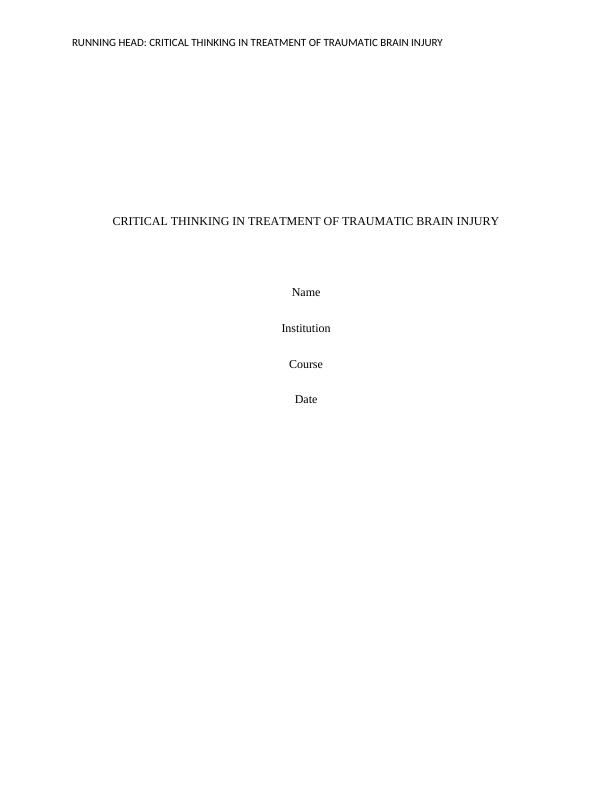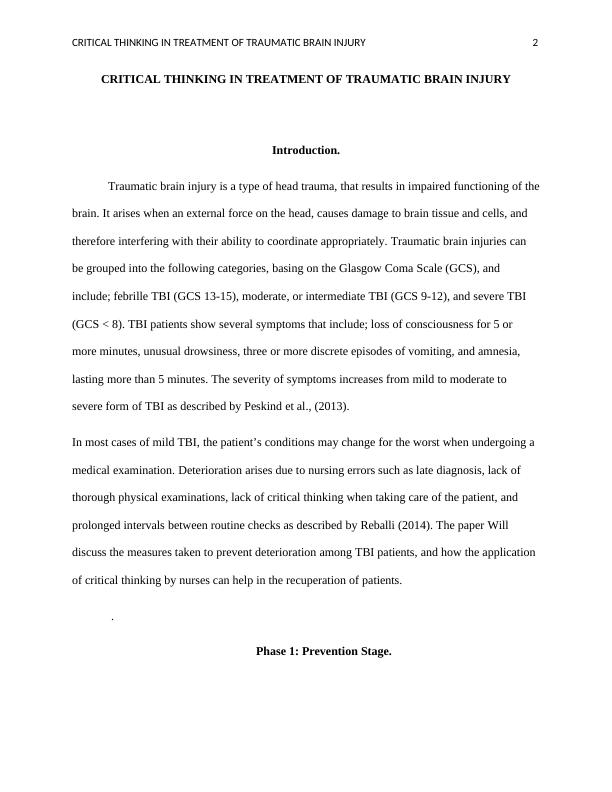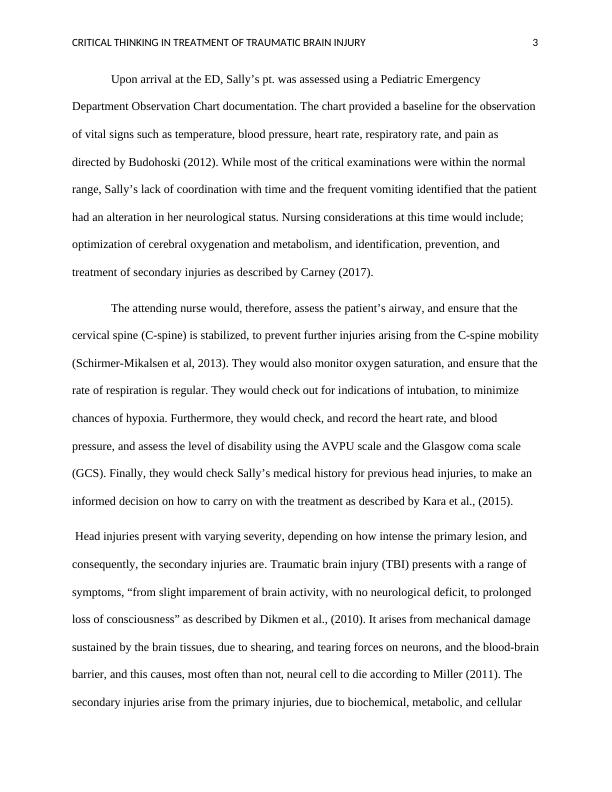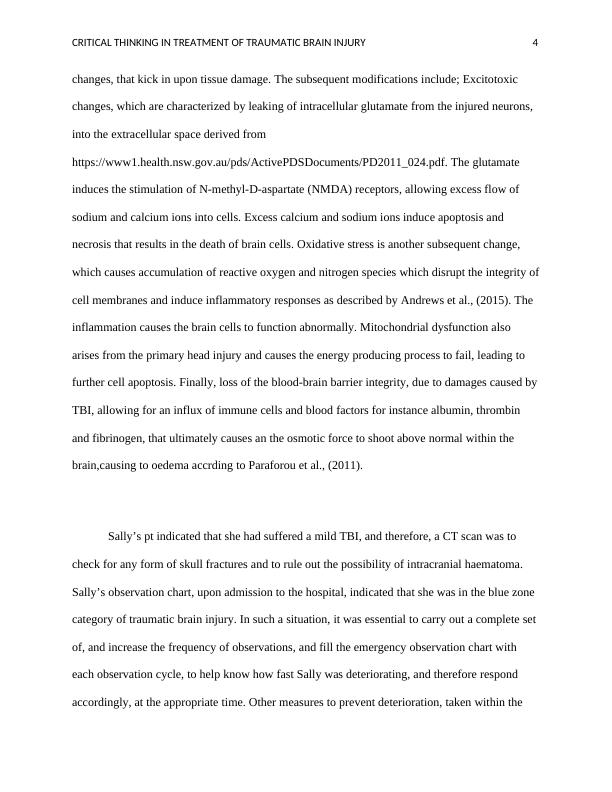Critical Thinking in Treatment of Traumatic Brain Injury
Added on 2023-03-23
12 Pages3330 Words72 Views
RUNNING HEAD: CRITICAL THINKING IN TREATMENT OF TRAUMATIC BRAIN INJURY
CRITICAL THINKING IN TREATMENT OF TRAUMATIC BRAIN INJURY
Name
Institution
Course
Date
CRITICAL THINKING IN TREATMENT OF TRAUMATIC BRAIN INJURY
Name
Institution
Course
Date

CRITICAL THINKING IN TREATMENT OF TRAUMATIC BRAIN INJURY 2
CRITICAL THINKING IN TREATMENT OF TRAUMATIC BRAIN INJURY
Introduction.
Traumatic brain injury is a type of head trauma, that results in impaired functioning of the
brain. It arises when an external force on the head, causes damage to brain tissue and cells, and
therefore interfering with their ability to coordinate appropriately. Traumatic brain injuries can
be grouped into the following categories, basing on the Glasgow Coma Scale (GCS), and
include; febrille TBI (GCS 13-15), moderate, or intermediate TBI (GCS 9-12), and severe TBI
(GCS < 8). TBI patients show several symptoms that include; loss of consciousness for 5 or
more minutes, unusual drowsiness, three or more discrete episodes of vomiting, and amnesia,
lasting more than 5 minutes. The severity of symptoms increases from mild to moderate to
severe form of TBI as described by Peskind et al., (2013).
In most cases of mild TBI, the patient’s conditions may change for the worst when undergoing a
medical examination. Deterioration arises due to nursing errors such as late diagnosis, lack of
thorough physical examinations, lack of critical thinking when taking care of the patient, and
prolonged intervals between routine checks as described by Reballi (2014). The paper Will
discuss the measures taken to prevent deterioration among TBI patients, and how the application
of critical thinking by nurses can help in the recuperation of patients.
.
Phase 1: Prevention Stage.
CRITICAL THINKING IN TREATMENT OF TRAUMATIC BRAIN INJURY
Introduction.
Traumatic brain injury is a type of head trauma, that results in impaired functioning of the
brain. It arises when an external force on the head, causes damage to brain tissue and cells, and
therefore interfering with their ability to coordinate appropriately. Traumatic brain injuries can
be grouped into the following categories, basing on the Glasgow Coma Scale (GCS), and
include; febrille TBI (GCS 13-15), moderate, or intermediate TBI (GCS 9-12), and severe TBI
(GCS < 8). TBI patients show several symptoms that include; loss of consciousness for 5 or
more minutes, unusual drowsiness, three or more discrete episodes of vomiting, and amnesia,
lasting more than 5 minutes. The severity of symptoms increases from mild to moderate to
severe form of TBI as described by Peskind et al., (2013).
In most cases of mild TBI, the patient’s conditions may change for the worst when undergoing a
medical examination. Deterioration arises due to nursing errors such as late diagnosis, lack of
thorough physical examinations, lack of critical thinking when taking care of the patient, and
prolonged intervals between routine checks as described by Reballi (2014). The paper Will
discuss the measures taken to prevent deterioration among TBI patients, and how the application
of critical thinking by nurses can help in the recuperation of patients.
.
Phase 1: Prevention Stage.

CRITICAL THINKING IN TREATMENT OF TRAUMATIC BRAIN INJURY 3
Upon arrival at the ED, Sally’s pt. was assessed using a Pediatric Emergency
Department Observation Chart documentation. The chart provided a baseline for the observation
of vital signs such as temperature, blood pressure, heart rate, respiratory rate, and pain as
directed by Budohoski (2012). While most of the critical examinations were within the normal
range, Sally’s lack of coordination with time and the frequent vomiting identified that the patient
had an alteration in her neurological status. Nursing considerations at this time would include;
optimization of cerebral oxygenation and metabolism, and identification, prevention, and
treatment of secondary injuries as described by Carney (2017).
The attending nurse would, therefore, assess the patient’s airway, and ensure that the
cervical spine (C-spine) is stabilized, to prevent further injuries arising from the C-spine mobility
(Schirmer‐Mikalsen et al, 2013). They would also monitor oxygen saturation, and ensure that the
rate of respiration is regular. They would check out for indications of intubation, to minimize
chances of hypoxia. Furthermore, they would check, and record the heart rate, and blood
pressure, and assess the level of disability using the AVPU scale and the Glasgow coma scale
(GCS). Finally, they would check Sally’s medical history for previous head injuries, to make an
informed decision on how to carry on with the treatment as described by Kara et al., (2015).
Head injuries present with varying severity, depending on how intense the primary lesion, and
consequently, the secondary injuries are. Traumatic brain injury (TBI) presents with a range of
symptoms, “from slight imparement of brain activity, with no neurological deficit, to prolonged
loss of consciousness” as described by Dikmen et al., (2010). It arises from mechanical damage
sustained by the brain tissues, due to shearing, and tearing forces on neurons, and the blood-brain
barrier, and this causes, most often than not, neural cell to die according to Miller (2011). The
secondary injuries arise from the primary injuries, due to biochemical, metabolic, and cellular
Upon arrival at the ED, Sally’s pt. was assessed using a Pediatric Emergency
Department Observation Chart documentation. The chart provided a baseline for the observation
of vital signs such as temperature, blood pressure, heart rate, respiratory rate, and pain as
directed by Budohoski (2012). While most of the critical examinations were within the normal
range, Sally’s lack of coordination with time and the frequent vomiting identified that the patient
had an alteration in her neurological status. Nursing considerations at this time would include;
optimization of cerebral oxygenation and metabolism, and identification, prevention, and
treatment of secondary injuries as described by Carney (2017).
The attending nurse would, therefore, assess the patient’s airway, and ensure that the
cervical spine (C-spine) is stabilized, to prevent further injuries arising from the C-spine mobility
(Schirmer‐Mikalsen et al, 2013). They would also monitor oxygen saturation, and ensure that the
rate of respiration is regular. They would check out for indications of intubation, to minimize
chances of hypoxia. Furthermore, they would check, and record the heart rate, and blood
pressure, and assess the level of disability using the AVPU scale and the Glasgow coma scale
(GCS). Finally, they would check Sally’s medical history for previous head injuries, to make an
informed decision on how to carry on with the treatment as described by Kara et al., (2015).
Head injuries present with varying severity, depending on how intense the primary lesion, and
consequently, the secondary injuries are. Traumatic brain injury (TBI) presents with a range of
symptoms, “from slight imparement of brain activity, with no neurological deficit, to prolonged
loss of consciousness” as described by Dikmen et al., (2010). It arises from mechanical damage
sustained by the brain tissues, due to shearing, and tearing forces on neurons, and the blood-brain
barrier, and this causes, most often than not, neural cell to die according to Miller (2011). The
secondary injuries arise from the primary injuries, due to biochemical, metabolic, and cellular

CRITICAL THINKING IN TREATMENT OF TRAUMATIC BRAIN INJURY 4
changes, that kick in upon tissue damage. The subsequent modifications include; Excitotoxic
changes, which are characterized by leaking of intracellular glutamate from the injured neurons,
into the extracellular space derived from
https://www1.health.nsw.gov.au/pds/ActivePDSDocuments/PD2011_024.pdf. The glutamate
induces the stimulation of N-methyl-D-aspartate (NMDA) receptors, allowing excess flow of
sodium and calcium ions into cells. Excess calcium and sodium ions induce apoptosis and
necrosis that results in the death of brain cells. Oxidative stress is another subsequent change,
which causes accumulation of reactive oxygen and nitrogen species which disrupt the integrity of
cell membranes and induce inflammatory responses as described by Andrews et al., (2015). The
inflammation causes the brain cells to function abnormally. Mitochondrial dysfunction also
arises from the primary head injury and causes the energy producing process to fail, leading to
further cell apoptosis. Finally, loss of the blood-brain barrier integrity, due to damages caused by
TBI, allowing for an influx of immune cells and blood factors for instance albumin, thrombin
and fibrinogen, that ultimately causes an the osmotic force to shoot above normal within the
brain,causing to oedema accrding to Paraforou et al., (2011).
Sally’s pt indicated that she had suffered a mild TBI, and therefore, a CT scan was to
check for any form of skull fractures and to rule out the possibility of intracranial haematoma.
Sally’s observation chart, upon admission to the hospital, indicated that she was in the blue zone
category of traumatic brain injury. In such a situation, it was essential to carry out a complete set
of, and increase the frequency of observations, and fill the emergency observation chart with
each observation cycle, to help know how fast Sally was deteriorating, and therefore respond
accordingly, at the appropriate time. Other measures to prevent deterioration, taken within the
changes, that kick in upon tissue damage. The subsequent modifications include; Excitotoxic
changes, which are characterized by leaking of intracellular glutamate from the injured neurons,
into the extracellular space derived from
https://www1.health.nsw.gov.au/pds/ActivePDSDocuments/PD2011_024.pdf. The glutamate
induces the stimulation of N-methyl-D-aspartate (NMDA) receptors, allowing excess flow of
sodium and calcium ions into cells. Excess calcium and sodium ions induce apoptosis and
necrosis that results in the death of brain cells. Oxidative stress is another subsequent change,
which causes accumulation of reactive oxygen and nitrogen species which disrupt the integrity of
cell membranes and induce inflammatory responses as described by Andrews et al., (2015). The
inflammation causes the brain cells to function abnormally. Mitochondrial dysfunction also
arises from the primary head injury and causes the energy producing process to fail, leading to
further cell apoptosis. Finally, loss of the blood-brain barrier integrity, due to damages caused by
TBI, allowing for an influx of immune cells and blood factors for instance albumin, thrombin
and fibrinogen, that ultimately causes an the osmotic force to shoot above normal within the
brain,causing to oedema accrding to Paraforou et al., (2011).
Sally’s pt indicated that she had suffered a mild TBI, and therefore, a CT scan was to
check for any form of skull fractures and to rule out the possibility of intracranial haematoma.
Sally’s observation chart, upon admission to the hospital, indicated that she was in the blue zone
category of traumatic brain injury. In such a situation, it was essential to carry out a complete set
of, and increase the frequency of observations, and fill the emergency observation chart with
each observation cycle, to help know how fast Sally was deteriorating, and therefore respond
accordingly, at the appropriate time. Other measures to prevent deterioration, taken within the

End of preview
Want to access all the pages? Upload your documents or become a member.
Related Documents
The Slippery Slope: Using Pathophysiological Concepts to Explain the Clinical Deterioration of a Patient with Traumatic Brain Injurylg...
|7
|3254
|267
Sally Brown Case Studylg...
|7
|2660
|26
Pathophysiology of Concussive Injuries and Treatmentlg...
|5
|782
|65
Near Drowning (Case Study Analysis)lg...
|14
|3198
|499
Nursing Assessments, Pain Management, and Ethical Framework in Patient Carelg...
|10
|2651
|95
A tool used in clinic to determine maximum time a patient wait for medical assessment and treatmentlg...
|6
|1671
|248
